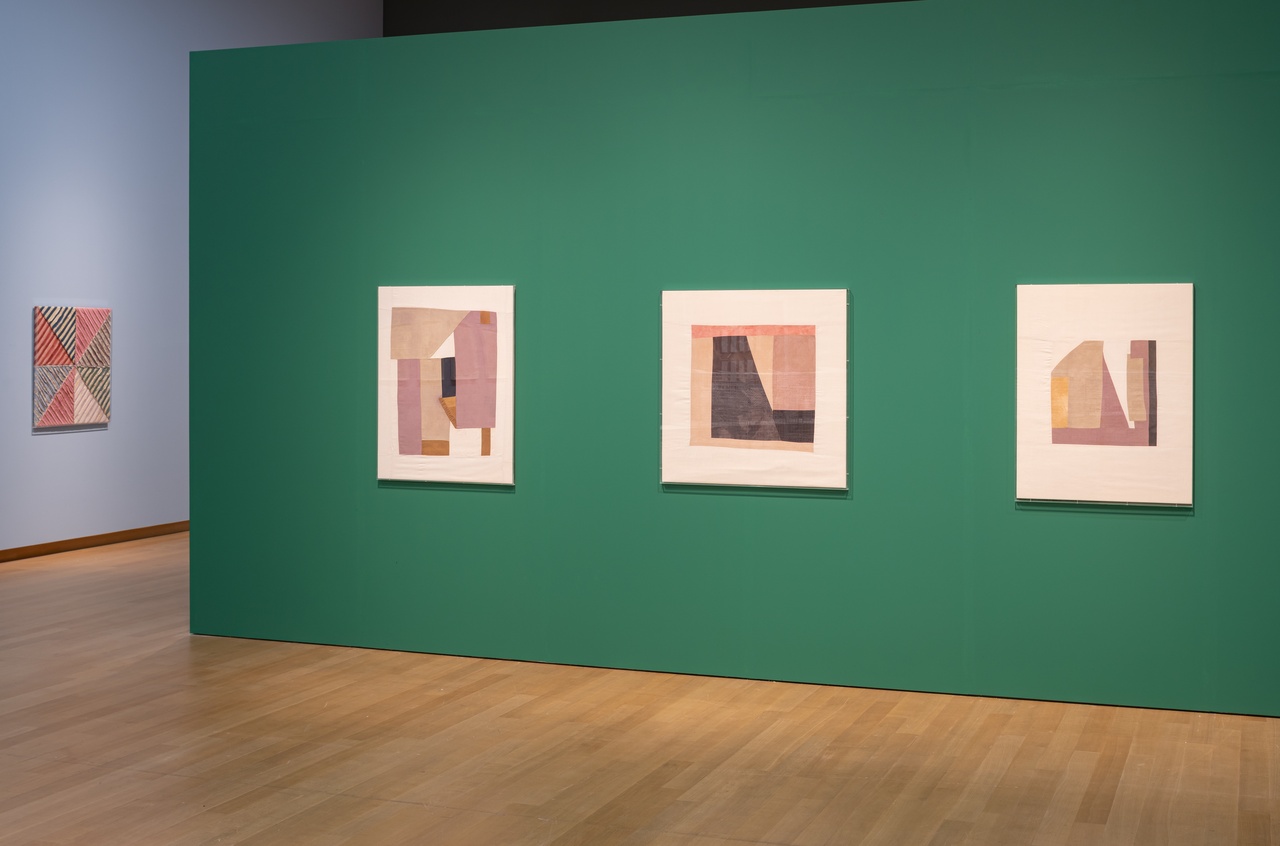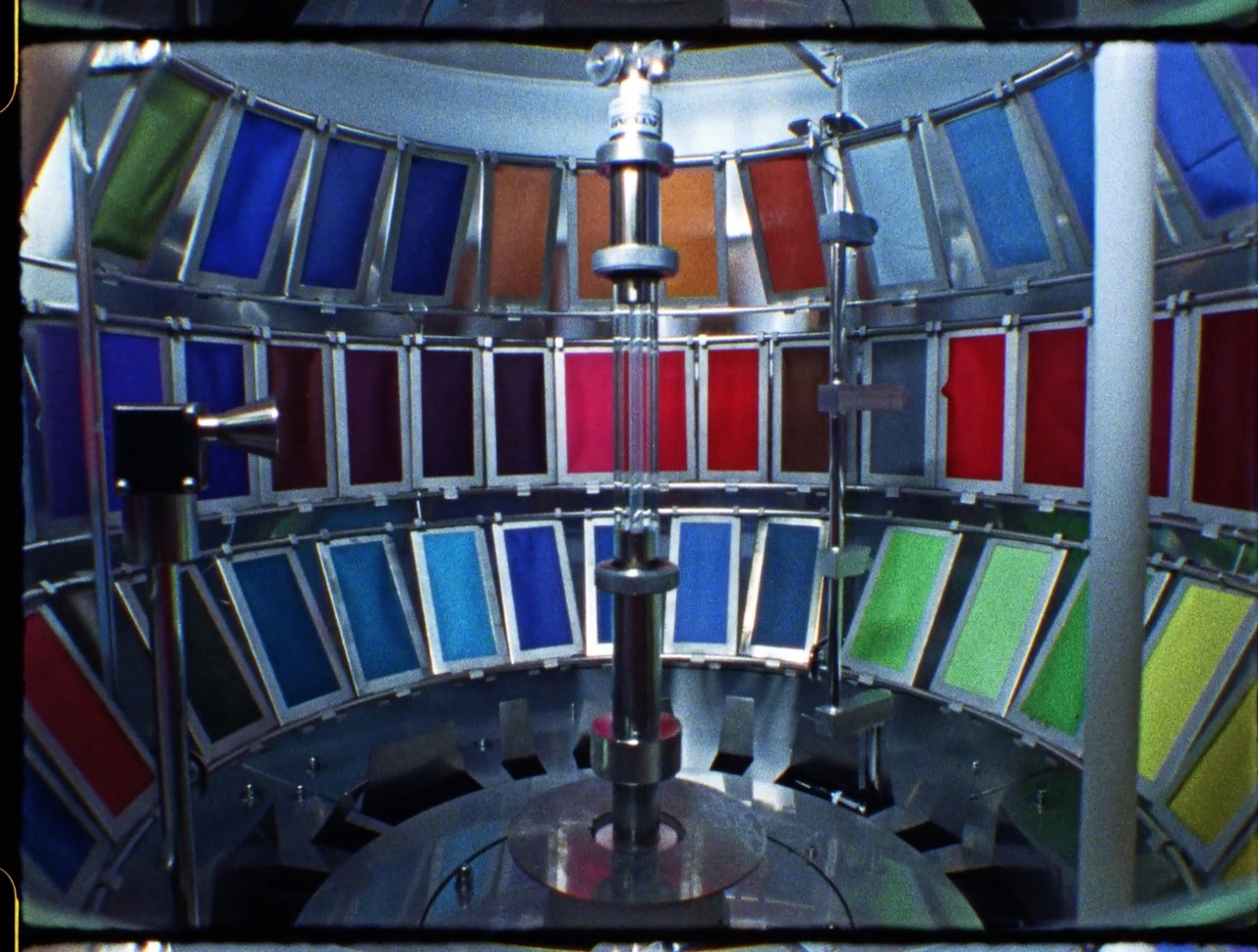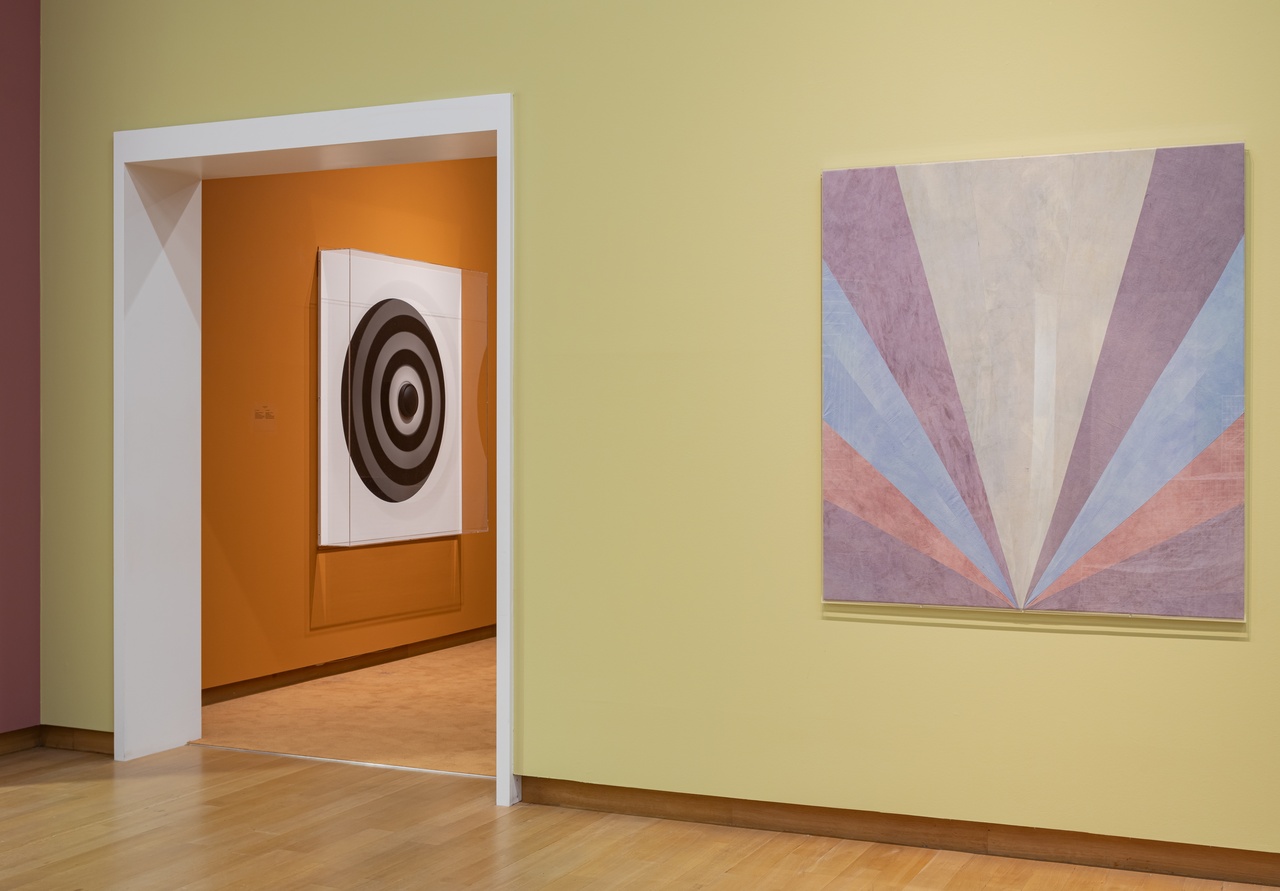IN THE MOTHERSHIP Christoph Chwatal on Yto Barrada at the Stedelijk Museum, Amsterdam

“Yto Barrada: Bad Color Combos,” Stedelijk Museum Amsterdam, 2022–23, installation view
Based between Tangier and New York, Yto Barrada is perhaps best known for her “para-institutional” projects. These span from the artist’s involvement in Beirut’s Arab Image Foundation to the founding of the Cinémathèque de Tanger in 2006, of which she remains acting president (alongside board members such as artist Bouchra Khalili and curator Rasha Salti). Operating as a non-profit organization, the Cinémathèque is housed in an illustrious movie theater dating from the late 1930s and acts as an arthouse cinema as well as an archive, research, and community center engaged in preserving the region’s cinematic heritage. Barrada’s most recent organizational endeavor is The Mothership, a research center-turned-residency housed on family-owned premises in Tangier, and to which her recent solo presentation “Bad Color Combos” speaks on several fronts. [1] Overlooking the Strait of Gibraltar, The Mothership’s gardens and summerhouse serve a variety of purposes, such as housing artists in residence and hosting dyeing workshops. [2] In the Amsterdam show, a large part of the exhibits materially relate to this institution, as they feature natural dyes sourced on-site by self-taught “dye-master” Barrada. Riffing on subjects such as motherhood, and with its name conjuring a popular Afrofuturist trope, [3] The Mothership encapsulates a wide range of concerns that undergird Barrada’s practice and gives shape to the artist’s interest in transgenerational and transdisciplinary (self-)learning.
In the upper floor of the Stedelijk’s annex, “Bad Color Combos” unfolded over three consecutive galleries, dividing the exhibition into four parts: a film and textile section, investigations into modernism, a “group show” within the exhibition, and a film screening. Across media such as painting, fiber arts, print, film, photography, and sculpture, the show included bodies of work from the last five years. The artist’s keen interest in cinematography and in film as a medium came to the fore in the show’s “opening scene”: a faint rattling set the tone of The Power of Two or Three Suns (2020), a sound habitually encountered in film exhibitions using obsolete analog media. First led to believe that this was the familiar sound of an analog projector, one soon found out that the piece was shot on 16mm film and transferred to a digital file. Emerging from a loudspeaker positioned underneath the projector, this was not the sound of the cinematic apparatus but rather that of the piece’s sole protagonist: a metal centrifuge with an oblong light bulb at its center and mounted with colored patches. The device exposes fabric samples (so-called swatches) to profuse UV radiation. As the film title suggests, its radiation of artificial light equals multiple times that of natural sunlight. In “Bad Color Combos,” the piece was further complemented by Velvet Collage #2 and Velvet Collage #8 (both 2021), which feature dozens of colored silk velvet swatches affixed on cardboard and framed. Alongside the film and a readymade (a traveling salesperson’s trunk containing neon light tube samples), the collages expanded Barrada’s explorations of the material-chemical practicalities of fabrics and dyes.

Yto Barrada, “The Power of Two or Three Suns,” 2020, film still
The next section of the show occupied the larger part of the brightly lit parquet-floored gallery, at whose center a stretched, low-rise sculpture cut the room at an angle. Formally recalling Sol LeWitt’s cubical structures, Tangier Island Wall (2022) comprises 42 painted crab traps, with up to three stacked upon each other, creating a waist-high barrier. The surrounding walls featured canvases and silver gelatin prints referencing modernist textile work and painting. Three pieces on display from Untitled (After Stella), an ongoing series started in 2018, involve stretched canvases made from cotton, linen, and silk (some of the material taken from Barrada’s bed linens) painted with self-made plant dyes. Frank Stella drew inspiration from Arabic tilework after a trip to Morocco in the early 1960s, naming pieces after cities, such as Marrakech (1964, the earliest work) and Sidi Ifni (1965, the latest). However, Stella is but one point of reference for Barrada, who seems to have had proponents of the Casablanca School in mind (painters such as Mohamed Chabâa and Mohamed Melehi). “Bad Color Combos” is the artist’s first solo show in the Netherlands, and this presentation is long overdue, especially when roaming through the Stedelijk’s collection: Barrada’s line of questioning into modernism appears profoundly entangled with the institution’s own inquiries into its collection. [4] While engaged in rethinking and expanding the canon, the Stedelijk’s presentation lacks such positions, and through the lens of Barrada’s show, these gaps become visible all the more forcefully.
A contrasting setting was presented in the adjoining gallery in an exhibition within the exhibition: soft carpet flooring blended with a tone-in-tone wall color (a warm earth tone), vitrines with bases in matching colors, and, in general, exhibits in smaller formats. Cocurated by Barrada, it featured works of artist-filmmaker Elodie Pong and the late conceptual artist Bettina Grossman. Such intergenerational histories and perspectives, often involving mutual learning and kinship, featured persistently in “Bad Color Combos” – an expanded family tree unfolding in the exhibition. Building on this, notions of learning and pedagogy were addressed earlier in the “modernism section,” for instance, by the sewing exercises illustrated in the gelatin silver print series Practice Piece (2019), and here they surfaced more directly in a series of 18 wood cutouts, Leaf Forms Puzzle (2020), and in Land and Water Forms (2019). This was further supported by Tamo’s Raft (Le radeau de Tamo) (2021), a small sculpture made of a wooden base, wire, wooden beads, and other materials, recalling a bead roller coaster, a popular children’s toy. As suggested in a letterpress print poster hung nearby, Bad Color Combos (Tamo’s Lists) (2022), it was also Tamo, one of the artist’s daughters, who also spurred the title of the show (with disliked combinations including “yellow & purple” and “indigo & turquoise”).

“Yto Barrada: Bad Color Combos,” Stedelijk Museum Amsterdam, 2022–23, installation view
The 36-minute film Tree Identification for Beginners (2017) ran as a loop in the final room, an auditorium with a steep wooden stair set which Barrada equipped with cushions made of plant-dyed fabric. The film is produced entirely in stop-motion, with colors and shapes as its protagonists. These recall what the mid-19th century pedagogue Friedrich Fröbel dubbed “gifts”: wooden blocks in different sizes and forms (planks, cubes, cylinders, spheres, or pyramids, depending on the child’s age) that further evoke the liberating potentials of learning and self-learning. As a ballet of shapes and colors unfolds on the visual plane, a voice narrates an episode involving the artist’s mother, Mounira Bouzid. In 1966, Bouzid took part in a trip organized by Operation Crossroads Africa, whose mission was to accommodate “ future leaders” from African countries on organized tours of the United States. One of the narrators reads from archival materials, among them a report detailing Bouzid’s stay, including evaluations and assessments of her behavior and potential. While perceived as an “alert and intelligent woman,” Bouzid’s critical stance toward the program (and the host country) didn’t go unnoticed. While the Vietnam War was still underway, Bouzid wanted to “go see the devil” for herself, as told by a female voice-over reading from her diary. On view simultaneously on three museum monitors with a substantial time-lapse, Continental Drift (2021), a digital video transferred from Super 8 film, splices together scenes from Tangier, New York, and Antarctica. This includes footage of a man putatively involved in the abduction of Barrada’s politically active grandfather decades ago. Weaving together different histories and temporalities, everyday scenes are juxtaposed with figures such as a man who goes by the name of Jerry, a Tangier-based cinephile and collector of magic lanterns who turns out to be a regular at the Cinémathèque.
Like the Cinémathèque, The Mothership resurfaced throughout the exhibition. For instance, Plan for a Dye Garden (2019) not only invoked Anni Albers’s woven textiles but could simultaneously be read as layouts of the research and residency center. More so, “Bad Color Combos” foregrounds how Barrada explores collective modes of working and ways of living through initiating, shaping, and securing sustainability beyond the scope of the individual and the artistry of her work. At the same time, the show attempts to articulate Barrada’s sensitivity to form, her often medium-specific concerns, and her art historical and institutional inquiries, and how these seemingly distinct endeavors can (and must be) thought of as operating in tandem. That is, the exhibition offers pathways of navigation through profound concerns with collectivity, organizing, and organizational forms to subtly yet decidedly posit them not as fringe activities but as driving forces.
“Yto Barrada: Bad Color Combos,” Stedelijk Museum, Amsterdam, October 22, 2022–March 5, 2023; Kunsthalle Bielefeld, March 25–July 30, 2023.
Christoph Chwatal is an art historian and critic based in Berlin.
Image credit: 1 + 3: Photo Peter Tijhuis; 2: © Yto Barrada, Courtesy Pace Gallery and Sfeir-Semler Gallery Beirut/Hamburg
Notes
| [1] | See Stedelijk Museum curator Leontine Coelewij’s report from a trip to Tangier and The Mothership in June 2022: “Yto Barrada: The Mothership in Tangier,” Stedelijk Studies, October 14, 2022. |
| [2] | As a place of both longing and death, the strait has been central to Barrada since A Life Full of Holes (1998–2004), a series of photographs inquiring into this sea border and the manifold histories of migration that surround it. |
| [3] | See the seminal anthology of speculative Afrofuturist fiction by Bill Campbell and Edward Austin Hall, eds., Mothership: Tales from Afrofuturism and Beyond (Greenbelt, MD: Rosarium Publishing, 2013). |
| [4] | On view in chapters such as “Everyday, Someday and Other Stories (1950 to 1980)” and “Tomorrow is a Different Day (1980 to present)” in the collection’s presentation. |
